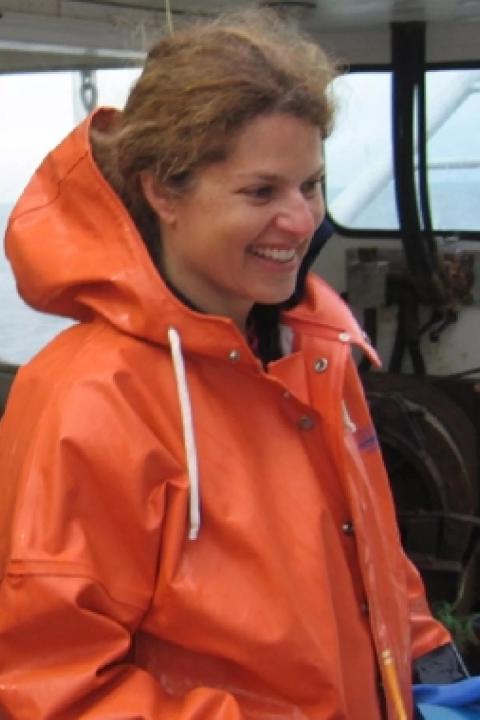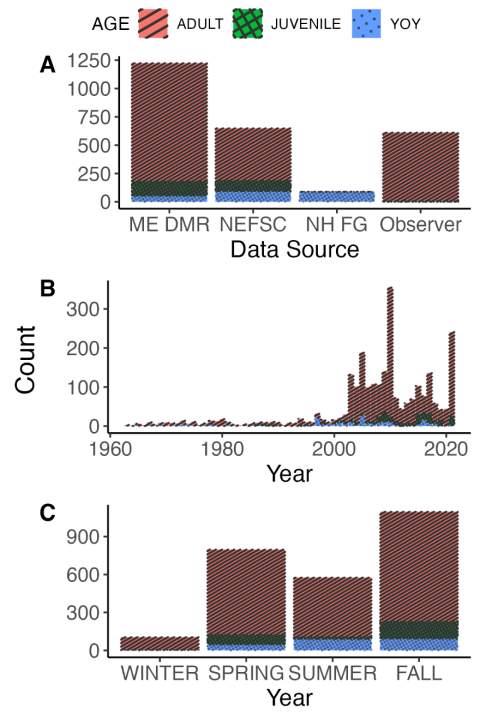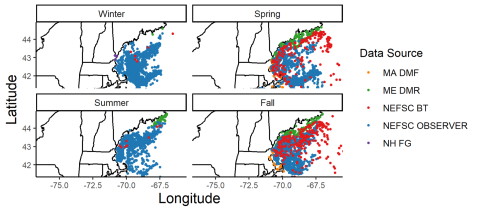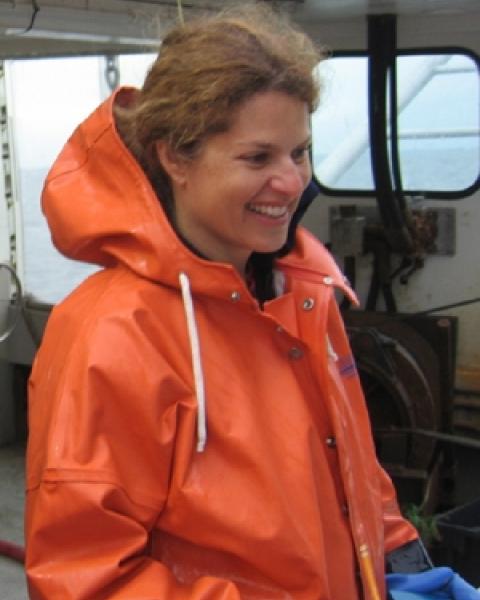This research was published in the INSPIRED: A Publication of the New Hampshire Agricultural Experiment Station (Fall 2024)
Researchers: E. A. Fairchild, E. R. White, S. Wulfing, S. Bradt, M. Doherty and K. Leavitt
Lumpfish (Cyclopterus lumpus) can provide biological controls of parasitic sea lice in salmon and trout farming operations. However, as the Gulf of Maine continues to rapidly warm, the changes are causing shifts in the distribution of marine species, including lumpfish. Understanding how the species' population dynamics in the Gulf of Maine change could be important to enable sustainable fisheries and aquaculture operations to implement biological controls across the Northeast. Aggregated data from fisheries surveys can help to examine changes in the Gulf of Maine lumpfish distribution over time, understand the relationship between population shifts and environmental factors, and establish a baseline for resource managers to support sustainable harvesting and aquaculture development.
Background and Key Concepts

Meet the Lumpfish! Scan the QR code and view an interactive map on lumpfish in the Gulf of Maine.
As the farmed salmon and trout industry in the Gulf of Maine (GoM) continues to grow, producers increasingly face risks from sea lice—marine parasites that attach to salmon and trout and eat on their host's tissue, leading to production losses and mortality. Because lumpfish can naturally graze on sea lice, they are being increasingly considered as a sustainable biocontrol, reducing the more environmentally costly chemical treatments.
Despite their potential use in aquaculture operations, lumpfish are not currently regulated in U.S. waters, there is no management plan for the species, and in Canada, lumpfish are listed as threatened due to fishing-related population declines. A key factor to developing sustainable management is baseline data on lumpfish biomass, occurrence, and distribution.
In the U.S., little is known about lumpfish populations. Lumpfish have been well studied in regions outside of the Gulf of Maine, but U.S. information is limited to studies in Great Bay Estuary, NH, and Schoodic Peninsula, ME.
Key Findings
- Lumpfish presence in the Gulf of Maine has increased since 1980.
- The distribution of lumpfish has shifted northeast over time, likely as a result of climate-induced warming.
- Lumpfish can play a role in sustainable biocontrol of sea lice. Managing their wild populations in the face of climate change and fishing pressure requires continued sampling and monitoring.
About the Co-author

Elizabeth Fairchild, Research Associate Professor of Biological Sciences
Contact information: Elizabeth.Fairchild@unh.edu, FindScholars profile

Fig. 2. Number of lumpfish caught by life history category (adult, juvenile, younger than one year old [abbreviated as YOY]) in the Gulf of Maine from 1963-2021 from all state and federal surveys depicted by (A) data source, (B) year, and (C) season. Chart A data sources include: Maine Department of Marine Resources (ME DMR), Northeast Fisheries Science Center (NFSC), New Hampshire Fish and Game (NH FG) and Observer data collected by commercial fishing vessels.
Lumpfish inhabit temperate waters (3-10 °C) in both the eastern and western Atlantic, occupying both pelagic and demersal zones with seasonal and depth-based distribution preferences. Semi-pelagic adults spawn inshore from March to May in the southwestern GoM, and May to June along northeast Maine. After spawning, females move offshore, while males guard the eggs. Juvenile lumpfish, associated with macroalgae, prey on small invertebrates before moving to deeper waters as they grow. Lumpfish can live up to 15 years, with males maturing in two to three years and females in three to four years.
Methodology
This study aggregated lumpfish catch data to characterize their distribution and assess the impact of water temperature on them over time. Researchers analyzed lumpfish catch data, sourced from Maine, New Hampshire, Massachusetts, and the Northeast Fisheries Science Center (NEFSC), from 1963 to 2021 (Table 1). Data included both fisheries-independent and fisheries-dependent surveys, detailing date, location, depth, and environmental variables like bottom temperature. Various survey methods, such as trawl and seine, were employed. Data were combined to map lumpfish distribution across seasons and depths. Generalized linear models assessed correlations with environmental factors, accounting for spatial autocorrelation. This comprehensive approach provided insights into lumpfish distribution shifts and their drivers.
Discussion of Findings
The analysis revealed that lumpfish presence in the GoM has increased over time, with significant seasonal and depth-related variations. Lumpfish are more likely to be found in deeper waters during the fall, correlated with colder bottom temperatures (Fig. 1). Over time, lumpfish shifted their distribution northeast, likely as a response to rising water temperatures—consistent with other species' responses to climate change. For lumpfish, the GoM represents the southern end of their range and, as it continues to warm, will likely become increasingly less suitable. Additional work is needed to understand how changes in other oceanographic variables, such as nitrate, salinity, and productivity, may interact with temperature increases and changes to fishing pressures to affect GoM marine species.
Strategic Recommendations and Conclusion

Fig. 1. Distributions of young-of-year (YOY; meaning younger than one year of age), juvenile and adult lumpfish caught in the Gulf of Maine from 1963-2021 from all state and federal surveys. MA DMF data are not included as lumpfish life history stage could not be calculated.
To meet the growing demand for lumpfish in GoM's aquaculture sector, it is crucial to manage wild populations sustainably. This involves continuous monitoring of lumpfish distribution and abundance, along with developing regulations to prevent overfishing. The findings provide vital baseline data for resource managers to develop informed conservation and aquaculture practices, ensuring the long-term sustainability of lumpfish populations in the GoM.
This material is based on work supported by the NH Agricultural Experiment Station through joint funding from the USDA National Institute of Food and Agriculture (under Hatch award number 7007270 and 7006646) and the state of New Hampshire.
